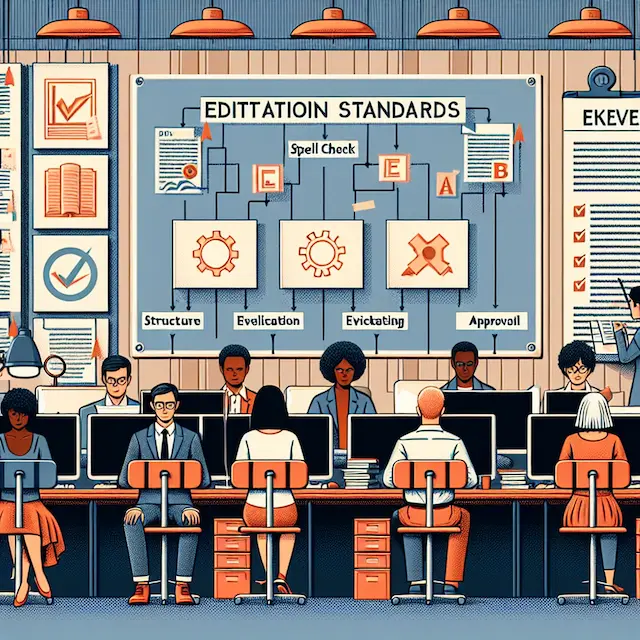In the evolving landscape of content creation, editorial standards & practices play a pivotal role in ensuring quality and integrity. These frameworks guide writers and organizations in producing trustworthy and engaging material.
As various media platforms proliferate, the need for established guidelines for editorial quality and integrity becomes increasingly crucial. Understanding these standards is essential for any entity looking to enhance its credibility and audience trust.
What are editorial standards?
Editorial standards refer to a set of principles and criteria established to govern the creation, review, and dissemination of content. These standards ensure that the content produced is not only accurate and reliable but also aligned with the values of the organization or publication.
Molte organizzazioni, come Bellingcat e Rocky Mountain Public Media, implementano rigorosi standard editoriali per mantenere la fiducia del proprio pubblico. Questi standard comprendono vari aspetti, tra cui la verifica dei fatti, la selezione delle fonti e il rispetto del giornalismo etico.
Establishing clear editorial standards helps in minimizing errors and biases in reporting. When writers adhere to these guidelines, the overall quality of content improves, leading to higher audience engagement and trust.
How do editorial standards ensure content quality?
Editorial standards serve as a benchmark for assessing the quality of content. They provide a framework for evaluating various factors such as accuracy, relevance, and clarity. This ensures that content not only meets audience expectations but also adheres to journalistic integrity.

For example, the AP Stylebook is a widely recognized set of standards that many news organizations follow. Adhering to such standards guarantees consistency in language, style, and formatting, which enhances readability and professionalism.
Moreover, editorial standards also promote accountability. When content creators know they are bound by established guidelines, they are more likely to produce work that is thoughtful and meticulously crafted. This accountability translates to greater trust among readers.
What are the key components of editorial standards?
Several key components make up comprehensive editorial standards. These include:
- Fact-checking: Ensuring the accuracy of information before publication.
- Sourcing: Using credible and reliable sources to support claims.
- Transparency: Being open about the processes involved in content creation.
- Ethical considerations: Addressing issues such as privacy and representation.
- Inclusivity: Ensuring diverse perspectives are represented in content.
By integrating these components into their editorial standards, organizations can build a foundation of trust with their audience. Each element contributes to the overall integrity and reliability of the content produced.
How can companies create effective editorial guidelines?
Creating effective editorial guidelines involves several strategic steps. Organizations must first assess their goals and values to align their editorial standards with their mission. This ensures that all content reflects the core principles of the organization.
Next, companies should involve diverse stakeholders in the development process. Including different voices can lead to more comprehensive and inclusive guidelines that resonate with a broader audience.
Additionally, it is vital to review and update editorial guidelines regularly. The media landscape is constantly evolving, and staying current with trends and audience expectations will enhance the effectiveness of the guidelines.
Why are editorial standards important in journalism?
Editorial standards are crucial in journalism as they uphold the integrity and credibility of the news. In an age of misinformation, having solid standards helps journalists distinguish between credible news and false claims.
Furthermore, these standards foster public trust. When audiences know that journalists adhere to strict editorial guidelines, they are more likely to engage with the content and share it within their networks. This is vital for maintaining a healthy democratic society.
Organizations like PBS have long upheld high editorial standards, contributing to their reputation as a reliable news source. By prioritizing these standards, they not only promote ethical journalism but also enhance audience engagement.
What role do ethical practices play in editorial standards?
Ethical practices are at the heart of editorial standards, guiding content creators in their decision-making processes. These practices ensure that content is produced responsibly and with consideration for the audience’s well-being.
For instance, ethical journalism emphasizes accuracy, fairness, and impartiality. By following these principles, journalists can avoid conflicts of interest and maintain credibility in their reporting.
Moreover, ethical practices promote transparency, which is essential for building trust with audiences. When organizations are open about their editorial processes, including corrections and updates, they foster a culture of accountability.
How does Bellingcat uphold its editorial standards?
Bellingcat is renowned for its investigative reporting and rigorous adherence to editorial standards. The organization employs a meticulous approach to verify information through open-source research and citizen journalism.
By prioritizing transparency, Bellingcat openly shares its methodologies and sources, allowing audiences to understand how conclusions are drawn. This not only enhances trust but also encourages audience engagement.
Furthermore, Bellingcat’s focus on ethical reporting ensures that it maintains the highest standards of journalism. Their commitment to accuracy and reliability sets a benchmark for other organizations in the field.
Questions related to editorial standards & practices
What are editorial guidelines?
Editorial guidelines are specific rules and principles that dictate how content should be created, edited, and published. These guidelines help ensure that the content adheres to the organization’s standards of quality and integrity.
They typically cover areas such as tone, style, formatting, and ethical considerations. By following these guidelines, writers can produce coherent and unified content that aligns with the organization’s voice and mission.
Why are editorial standards important for organizations?
Editorial standards are essential for organizations as they help maintain a consistent voice and quality across all content. This consistency is vital for establishing brand identity and trust with audiences.
Additionally, adhering to editorial standards minimizes the risk of errors and miscommunication. Organizations that prioritize these standards are better equipped to enhance their reputation and ensure long-term success in content creation.




